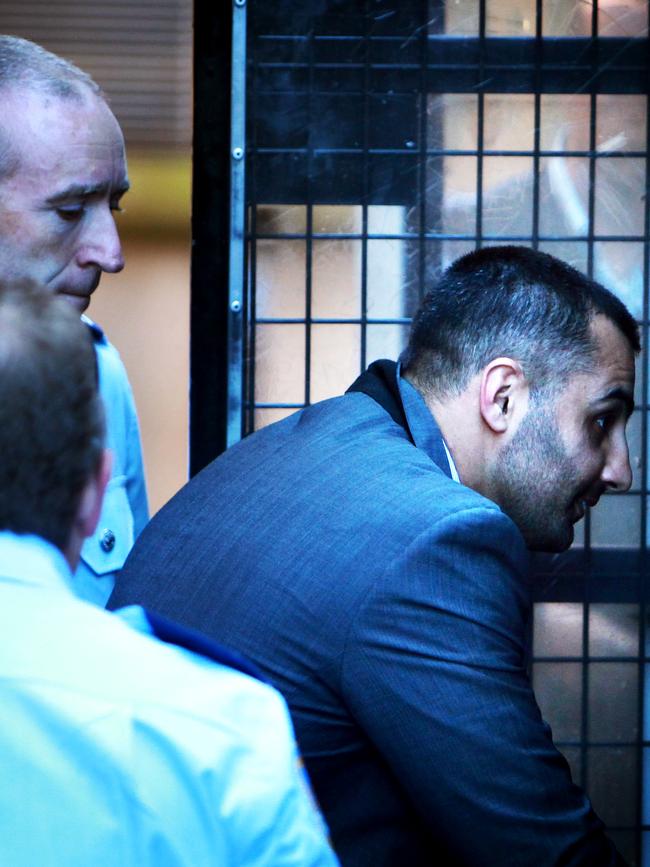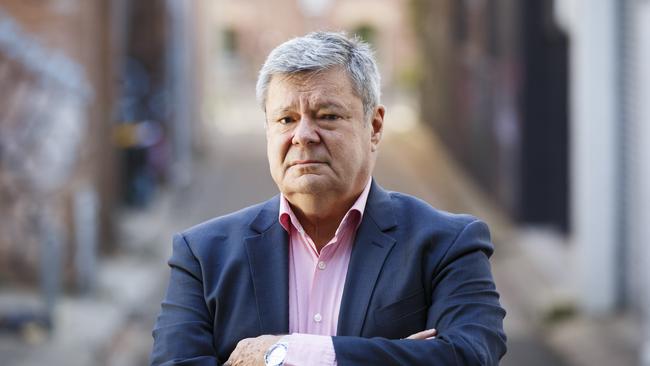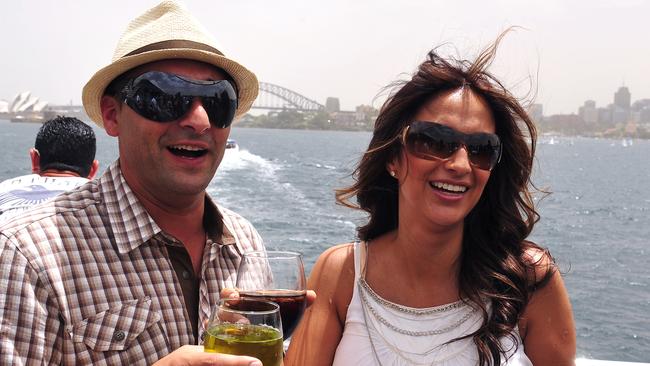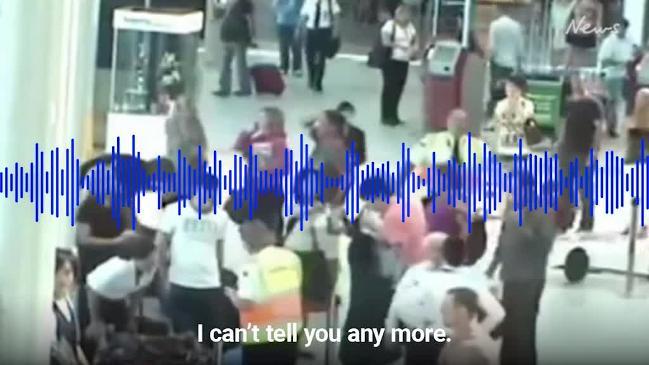The severe consequences that would follow if Hawi lost his murder trial were weighing heavily on him, so he made an offer to try and avoid it. On April 29, 2011, he tried to cut a deal with prosecutors to plead guilty to manslaughter and avoid his murder trial all together.
It was 10 days before the trial was due to start in the NSW Supreme Court. The Office of the Director of Public Prosecutions rejected Hawi’s offer and informed his lawyers they intended to proceed with the murder charges.
Hawi had no other option other than to get ready for a different kind of fight.
The trial was brutal in length. The legal equivalent of taking part in a 12-round bare-knuckle fight followed by a triathlon. It ran for five gruelling months.
Hawi stuck to his line in the witness stand.
“I was the victim. They wanted to kill me,” he said while giving evidence.
At another point in the trial, Hawi told the jury: “I didn’t intend to kill anyone.”
He ran a defence based on provocation, duress and self defence. The jury rejected them all.
After 34 agonising days of deliberating, Hawi was notified that the jury had reached a decision.
On November 2, 2011, the jury convened at the NSW Supreme Court sitting at Parramatta and informed Hawi of his fate: “Guilty.”



Chapter 1: Tattoos that told the life story of Mick Hawi
Chapter 2: Comanchero boss Hawi a rare one-woman bikie
Chapter 3: Bikie brawl and airport killing changed Sydney forever
Chapter 4: Depressed Hawi’s world falls apart
Chapter 5: Money troubles before Hawi’s life ends in a hail of bullets
If the length of the trial had been emotional strain, this singular moment was infinitely worse.
It wasn’t what he wanted, but Hawi was the captain going down with the ship.
Of the 12 Comanchero members charged over the Sydney Airport brawl, he was the only one found guilty of murder.
His underlings, Christian Menzies, Ishmail Eken, Zoran Kisacanin, Usama Potros and Farres Abounader were all acquitted of murder.
Menzies was sentenced to three years jail after pleading guilty to manslaughter and affray.
Hawi would have to wait another agonising 160 days before he would find out how long his prison sentence would be.
It was crushing.
On April 10, 2012, Justice Robert Alaln Hulme sentenced Hawi to a maximum of 28 years and six months with a non-parole period of 21 years and six months.
“He expressed bewilderment at the verdict but nonetheless is well aware of the consequences of this decision in terms of his future life,” psychologist Tim Watson-Munro wrote in a report that was tendered to court following a session with Hawi.
Hawi would later tell Dr Watson-Munro the daily routine of being trucked to court from Silverwater Prison was gruelling.
“It destroyed me,” Hawi told Dr Watson-Munro during one of their sessions.
Reflecting on the anxiety it caused him, Hawi said: “I might have to do it all again for the appeal.”

Dr Watson-Munro wrote: “This was an arduous time for (Hawi) in the context of his statements that he was generally out of bed each day at 4.30am each morning and returned to the jail at 6pm that day.”
There were several surprises that emerged in the trial, including evidence that Hawi actually knew Peter and Anthony Zervas because they all went to school together.
Adding to Hawi’s despair, his refrigeration truck company, which employed his father, had failed while he was on trial.
Following the verdict, Gonzales left the court and was photographed getting into a car stony-faced. The horrendous emotions she was experiencing would have to wait until she was not under the glare of the media.
While the future appeared bleak for Hawi and his supporters, there was one glimmer of hope.
They were three sentences delivered by Justice Hulme during the court of his judgment.
“I am not satisfied that (Hawi) was the person who inflicted the blow, or blows, which caused (Zervas’) fractured skull,” Justice Hulme told the court.
“ … I am not satisfied beyond reasonable doubt that the offender inflicted any blows at all,” he told the court.
The observation would become critical to Hawi’s appeal and prospects for freedom.

HAWI’S EMOTIONAL PRISON PAIN
Feelings of emotional vulnerability.
Bikie bosses aren’t supposed to have them. And if they do, they are forbidden from admitting they experience them.
“I am so sad or unhappy that I can’t stand it.”
“I feel my future is hopeless and will only get worse.”
“I feel I am a total failure as a person.”
“I can’t get any pleasure from the things I used to enjoy.”
Mick Hawi admitted to experiencing all of these feelings during his time in jail.
The admissions came when Hawi opened up to leading criminal psychologist Tim Watson-Munro, whose report was tendered to court.
It was a startling confession considering that in the animalistic world of bikies and criminals an admission like this was guaranteed to result in his death. Either at the hands of an enemy who caught the scent of weakness, or an ambitious underling hungry to kill the king and take the crown.
But this is where Hawi’s three years in prison had pushed him by 2012.
“ … He wishes he could cry but is unable to do so,” Dr Watson-Munro wrote in his report after analysing Hawi in February 2012.
Hawi maintained a tough exterior in prison for the sake of survival, but inside he had fallen apart.

“Despite being a proud man who keeps his feelings to himself … Mr Hawi conceded that he has been very depressed at times and is clearly suffering substantial anxiety,” Dr Watson-Munro wrote.
Hawi wasn’t suicidal but was experiencing severe depression, feelings of guilt, and lived under a cloud of low self esteem and self confidence.
On top of that, he was experiencing severe anxiety and had lost his libido.
“I have lost interest in sex completely,” Hawi told Dr Watson-Munro during one of their sessions.
The anxiety kept him on edge.
“I am so restless or agitated that I have to keep moving or doing something,” Hawi said during the consultation. “I am much more irritable than usual.’
Dr Watson-Munro diagnosed Hawi with chronic anxiety disorder with strong features of major depression.
There were several factors driving Hawi’s state.
The first was that he believed he was wrongly convicted and would serve 28 years in jail.
His jailing meant he lost the national presidency of the Comanchero, a position that Hawi told Dr Watson-Munro he hinged a lot of his self-worth on.
“ … He laments the loss of his reputation and fears that because of the verdict, he will spend many years in jail, which in turn will impact upon (his) family dynamic.
Hawi also knew his wife was struggling on the outside without him.

Ms Gonzales was experiencing numerous stress medical problems since he was behind bars like being admitted to hospital suffering heart palpitations and chest pains.
And it was weighing heavily on him that he was not able to bond with their newborn son.
Hawi’s mother, Nahda, was also struggling. She had taken to seeing a psychologist and had been diagnosed with a severe depressive disorder.
“She cannot fathom how her beloved son could be convicted of such atrocity and she is suffering deeply,” Dr Aiman Alsayed wrote in a letter that was tendered to court.
Hawi himself was suffering a form of post traumatic stress disorder, experiencing flashbacks to the Sydney Airport incident. He was also hypervigilant to danger and couldn’t sleep.
Hawi asked the doctor for sleeping tablets, but nothing psychotropic, adding: “I am paranoid about pills”
Then Hawi had to deal with prison itself. It is an unforgiving place and Hawi wasn’t ready for it.
By Hawi’s count, he spent nine and a half months in solitary confinement -- mostly for his own safety. It broke his spirit.
With his limited criminal record, Hawi had never served a prison term before 2009.
Hawi’s first stint behind bars began on April 6, 2009, when he was charged with affray over the Sydney Airport brawl and refused bail after he was charged with rioting over the same brawl on May 19, 2009.
He got the full treatment when he arrived at Silverwater Prison’s Metropolitan Remand and Reception Centre.
MRRC is a maximum-security prison that houses prisoners on remand or while they are waiting to be transferred to another prison.
Hawi was issued a MIN number, a unique code that is the identifier on each prisoner’s file: 453375.
The first entry on that file came on April 7, 2009, when prison authorities ruled he was not to associate with Michael Ibrahim.
It is not known the reason for the non-association.
More than a year later, police received intelligence of an allegation that Michael Ibrahim allegedly put out a contract to have Hawi killed in early 2009. But investigators were unable to confirm if it was true.
Ibrahim was never charged and there is no suggestion of his involvement.
The second note on the same day said Hawi was to be kept away from “all other inmates due to possible threats from Rebels and Notorious OMCGs.”
A third stated he was not to be placed in the same correctional centre or escort vehicle with “any member or associate of the Hells Angels and Notorious OMCGs” for obvious reasons.
After being released on bail on May 20, 2009, Hawi returned to MRRC for the start of his longest prison stint on July 1, 2009, when he was charged with Zervas’ murder.
For his own safety, he was put in solitary confinement and later told Dr Watson-Munro that being “locked down” for 24 hours a day was an excruciating experience.
Showing how green he was to the prison life, Hawi thought every prisoner lived in solitary confinement.

“Reflective of his lack of exposure to the prison subculture,” Dr Watson Munro wrote. “Mr Hawi stated that initially he thought this was the norm for all prisoners and it as not until he noticed when being taken to visits, prisoners working in the garden and exercising in the yard that he realised his situation was different.”
In total, Hawi claimed he spent nine-and-a-half months in solitary confinement before being allowed back into the main prison yard.
“He reported being highly traumatised by the isolation…,” Dr Watson-Munro wrote.
The only thing that kept him going was a steady stream of visitors, ranging from family to lawyers.
In the 12 months leading up to February 2012, 76 people visited Hawi in jail.
Every day was the same.
Prison guards released Hawi at 8.30am before he was locked up in his solitary cell again between 11.15am and 12.30pm. His final lock up was at 3.30pm.
Talking to his family kept him sane.
“When not in his cell and reflective of his love of his family (Hawi) stated ‘I spend my whole time speaking to them and my children’,” Dr Watson-Munro wrote.
But on May 8, 2015, Hawi’s stay at the complex ended more than 20 years earlier than expected.
‘IT’S PARTY TIME’ - HAWI FREED ON BAIL
Salvation for Hawi came on May 16, 2014.
It was the day the NSW Court of Criminal Appeal handed down its decision to overturn Hawi’s murder conviction.
The 33-year-old had been in jail and away from his family for 1781 days since being charged with Anthony Zervas’ murder.
Now, the prospect of seeing them again as a free man loomed.
Hawi’s conviction and soul crushing 28-year jail sentence had been wiped away.
A three-judge panel in the court ruled by a 2-1 majority that the jury’s decision to convict him was not supported by the evidence.
Chief Justice Tom Bathurst told the court he could not be satisfied beyond a reasonable doubt that Hawi inflicted the blows to Zervas’ head and indicated he would have acquitted him.
Justice Derek Price wanted Hawi to be retried, while Justice Lucy McCallum wanted to dismiss Hawi’s appeal altogether and have him serve the rest of his sentence.
Ultimately, the court took the middle ground and ruled to quash Hawi’s conviction, but also ordered a retrial.
Hawi’s appeal submissions included more than 5000 pages of transcript and 200 pages of other written material.
But it ultimately boiled down to two points.
The first was, did the evidence prove beyond a reasonable doubt that it was Hawi who fatally struck Zervas with a metal bollard.
After sifting through a mountain of conflicting eyewitness statements and video recordings, Justice Bathurst told the court he could not be satisfied beyond a reasonable doubt.
“It is a doubt I believe the jury should have held and it was not open for the appellant to be convicted on the basis that he inflicted the fatal blow or some of the blows which caused death,” Justice Bathurst told the court.
The second was that if Hawi’s co-accused had all been acquitted of murder, how could they be part of a joint criminal enterprise to murder Zervas?
This joint criminal enterprise argument meant Hawi may not have inflicted the fatal blow or blows to Zervas, but was part of a group where someone had.
But with all of his fellow Comanchero acquitted of murder -- and only two guilty of manslaughter — it left a logical conundrum where if Hawi didn’t land the fatal blow, how could he be part of a one-man joint criminal enterprise?
Justice Bathurst found that he couldn’t.
It was a momentous blow, not just to the prosecution, but to the investigating police, the Zervas family and any member of the public who watched the carnage that unfolded in Sydney Airport on March 22, 2009 and felt unsafe from the threat of bikie violence as a result.
Hawi on the other hand was overjoyed. He could taste freedom.
But there was still the question of his retrial.
GALLERY:
The Office of the Director of Public Prosecutions was now in a bind and had a tough decision to make.
The triumph of landing a conviction and a crippling 28-year jail sentence on a big fish like Hawi was gone.
Now, thanks to the CCA judgment, so too was the strength of the prosecution’s case in the looming retrial.
And Hawi’s legal team knew it, and capitalised.
On June 4, 2014, Hawi’s lawyers made an official offer to the ODPP to plead guilty to the lesser charge of manslaughter.
Hawi had more good fortune coming his way.
The situation with his appeal came at the same time that the NSW Liberal Government introduced a controversial new set of bail laws.

The critical aspect of the laws removed the presumption against release for serious offences and instead considered if the person was an unacceptable risk to the community.
The architect of the laws, then Attorney-General Greg Smith, was criticised for softening the bail laws and making it too easy for accused serious criminals to be released.
Hawi didn’t miss his opportunity and hired Australia’s best barrister Brett Walker SC, who is rumoured to charge in the vicinity of $25,000 a day for his services.
Mr Walker told the Supreme Court during Hawi’s bail application that the revised Act — which had only been in effect for one month — “places us on the right side” of receiving bail.
He was right and Justice Ian Harrison granted Hawi bail and explained his decision at the end of his judgment.
“It is naturally and critically important that every individual is treated individually and that we as a society never rush to general conclusions about whether an arrested person is guilty, or will be convicted, of an offence with which he or she is charged,” Justice Harrison told the court.
“The society in which we all live ought strenuously to turn its face against the making of unproved assumptions about guilt or innocence, or worse still, automatically and unquestioningly depriving people of their liberty, or continuing to do so, unless or until the assumptions are made good,” he told the court.
One of Hawi’s supporters in the court summed up the mood differently, yelling: “It’s party time.”

Hawi walked free from Lithgow Jail on June 25, 2014, after one of his supporters was able to raise $700,000.
He was picked up from the jail in a white Mercedes van.
The experiences of the last five years were showing and had aged Hawi noticeable. The hair on the side of his head was now completely grey and could not be disguised by having the barber cut it shorter.
Meanwhile, the bail decision was met with a storm of anger and controversy, which was all worn by Attorney-General Smith.
Things kept getting better for Hawi.
On July 25, 2014, the ODPP informed his lawyers the office had accepted his plea to manslaughter and would not be pursuing him for murder.
It was made official in the NSW Supreme Court on September 6. In a short hearing, Hawi officially pleaded guilty to manslaughter.
Now it was only a question of if he would do any more jail time, or would his manslaughter sentence be covered by the more than five years he had already spent behind bars.
He must have been feeling good about his chances.
Chapter 3: The bloody airport brawl and death that led to the jailing of Mick Hawi
Reporters noted that he appeared to be in a “buoyant mood” when he blew a large pink bubblegum bubble in their direction as he arrived at the NSW Supreme Court on March 13, 2014.
But an hour later, he looked deflated. His freedom was short lived.
Hawi’s lawyers argued that to send him back to jail would be unfair.
Justice Cliff Hoeben didn’t think so.
He rejected the argument and told the court that while Hawi’s situation was “unfortunate” there was a need for “deterrence and denunciation” and no exceptions would be allowed.
For the manslaughter of Anthony Zervas, Hawi was sentenced to a maximum of six years and two months with a non parole period of three years and six months.
Hawi hung his head and gave his lawyers a wry smile.
It was not a 28-year sentence. Hawi would serve just under three more months in jail because of time served.
Hawi walked out of jail for the last time on May 8, 2015, after being granted parole.
The 34-year-old was whisked away to a rural address after the State Parole Authority approved his parole, subject to 22 conditions.
It would be almost three years before the public heard Hawi’s name again. But when his name re-emerged, it was in the most dramatic of circumstances.

